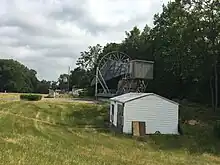
Crawford Hill, sometimes known in the past as Crawford's Hill, is located in Holmdel Township, New Jersey, United States. It is Monmouth County's highest point, as well as the highest point in New Jersey's coastal plain, standing 391 feet (119 m) above sea level.[1] The hill is best known as the site of an annex to the Bell Labs Holmdel Complex.
Crawford Hill is part of the cuesta known as the Atlantic highlands landform of New Jersey.[1] In such form it the highest of a series of rolling crests that recede from the shoreline.[2] In the past it was a wooded area overlooking the first farms in the area.[3] It is named after one of the longstanding, prominent families of Holmdel,[3] a name which goes back to an early figure in the area, William H. Crawford.[4] Its height was determined at least as early as 1888.[5]
Around 1900, part of Crawford Hill was leveled to make an easier through route for the Holmdel and Keyport Turnpike.[3] In the 1920s, driving over the hill was considered one of the rewarding local routes that the new generation of motorists could undertake.[6] By the 1930s, the hill had a number of roadways on it as well as several working gravel pits that were WPA projects.[7]
Crawford Hill overlooks the Garden State Parkway; on the other side of that road is Telegraph Hill and the formerly named Garden State Arts Center.[8] If a view were to be unobstructed, Lower New York Bay can be seen as well as some of the New York skyline.[7]
During the 1940s and 1950s, the hill was used by the Jersey Shore Amateur Radio Association to compete in contests run by the American Radio Relay League involving the setting up of a field station and then contacting the most other amateur stations; the association came in first in the contests held in 1946 and again in 1958.[9][10]
Arno Penzias and Robert Wilson of Bell Labs used the Holmdel Horn Antenna located on Crawford Hill to take measurements of the cosmic microwave background radiation. They were awarded the 1978 Nobel Prize in Physics for these efforts that supported the Big Bang theory. For more information, see Discovery of cosmic microwave background radiation.
More recently the laboratory has undertaken research in the fields of wireless and fiber-optic communication and award-winning Bell Laboratories researchers in these fields, working at Crawford Hill include Herwig Kogelnik and Gerard Foschini.
Herwig Kogelnik won the 2001 Marconi International Fellowship Award and IEEE Medal of Honor for his work in the development of fiber optic technology and the 2006 National Medal of Technology.
Gerard J. Foschini[11] was the 2002 recipient of the Thomas Alva Edison Patent Award for his pioneering inventions having to do with the capacity of communications systems with multiple antennas.
In 2020, Nokia sold the Crawford Hill facility and relocated the remaining Bell Labs research staff to the Murray Hill campus.
See also
References
- 1 2 Hordon, Robert M. (2004). "Atlantic Highlands". In Lurie, Maxine N.; Mappen, Marc (eds.). Encyclopedia of New Jersey. Rutgers University Press. p. 45.
- ↑ Cliver, Alvin B. (August 21, 1949). "Monmouth County's Topography Most Diversified Along Seacoast". Asbury Park Sunday Press. p. 6 – via Newspapers.com.
- 1 2 3 Ceres, Gerald V. (1996). Holmdel and Pleasant Valley. Images of America. Charleston, South Carolina: Arcadia Publishing. pp. 23–27, 34.
- ↑ Ellis, Franklin (1885). History of Monmouth County, New Jersey. Philadelphia: R. T. Peck & Co. pp. 814, 816.
- ↑ Final Report of the State Geologist. Vol. 1. Trenton: Geological Survey of New Jersey. 1888. p. 287.
- ↑ "Tinton Falls Is Historic Place". Asbury Park Evening Press. September 17, 1924. p. 7 – via Newspapers.com.
- 1 2 "Gravel From On High". Red Bank Register. Freehold Transcript. August 25, 1938. p. 6 – via Newspapers.com.
- ↑ "Crawford Hill NJ". Lists of John. Retrieved March 20, 2012.
- ↑ "National Radio Contest Won By Shore Group". Red Bank Register. March 13, 1947. p. 15 – via Newspapers.com.
- ↑ "Garden State Radio Hams Win 24-Hour American Relay Drill". Asbury Park Sunday Press. December 21, 1958. p. 3 – via Newspapers.com.
- ↑ "Lucent - Bell Labs - Feature - Foschini Receives Edison Award for BLAST". Archived from the original on 2006-03-27. Retrieved 2006-06-09.
External links
- Herwig Kogelnik IEEE Award Web Site
- Gerard J. Foschini on the Bell Labs web site
- Gerard. J. Foschini and Michael. J. Gans (1998). "On limits of wireless communications in a fading environment when using multiple antennas" (PDF). Wireless Personal Communications. 6 (3): 311–335. doi:10.1023/A:1008889222784. S2CID 6157164. Archived from the original (PDF) on 2005-05-11.
40°23′28″N 74°11′07″W / 40.39111°N 74.18528°W